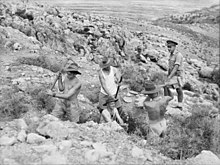70th Battalion (Australia)
| 2/31st Battalion | |
|---|---|

Soldiers from the 2/31st dig a section defence post in Syria during October 1941
|
|
| Active | 1940–1946 |
| Country | Australia |
| Branch | Australian Army |
| Type | Infantry |
| Size | 800–1,000 men |
| Part of | 25th Brigade, 7th Division |
| Motto(s) | Forever Forward |
| Colours | Black over Red |
| Engagements | |
| Commanders | |
| Notable commanders |
Selwyn Porter Murray Robson |
| Insignia | |
| Unit Colour Patch |  |
The 2/31st Battalion was an infantry battalion of the Australian Army that served during World War II. It was raised in June 1940 and was assigned to the 25th Brigade, 7th Division. It initially served in the United Kingdom where it undertook defensive duties before being moved to the Middle East in 1941. After taking part in the fighting in Syria and Lebanon, the battalion undertook garrison duties around Tripoli before being transferred back to Australia in 1942. In late 1942 the battalion was sent to New Guinea to fight against the Japanese along the Kokoda Track. They subsequently fought a number of battles throughout 1942, 1943 and early 1944. Their last campaign came in mid-1945 when they landed on Borneo. After the war the battalion was disbanded in March 1946.
The battalion was formed in the United Kingdom on 27 June 1940 from Second Australian Imperial Force (2nd AIF) personnel that had originally been designated for service in non-infantry roles who were grouped together to form an infantry battalion. Initially designated as the "70th Battalion", due to manpower shortages at first it was composed of only three rifle companies instead of the normal establishment of four. Under the command of Lieutenant Colonel Horace Strutt the battalion was initially based at Tidworth. In August 1940, Strutt was replaced with Lieutenant Colonel Ragnar Garrett as commanding officer. In October 1940, the battalion's designation was changed to the "2/31st Battalion" in order to bring it in line with the designations of the rest of the 2nd AIF, and it moved to Colchester. In November, the battalion was assigned to the 25th Brigade. It was during this time the battalion suffered its first casualty, when one of its members was killed in a German air raid. While in England the battalion undertook training and was employed on defensive duties, guarding against a possible invasion by German forces.
...
Wikipedia
